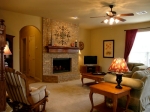![livingroomoveralliStock_000003431518XSmall[1]](https://balanceaustin.files.wordpress.com/2011/02/livingroomoverallistock_000003431518xsmall12.jpg?w=150&h=99) A living room is a place for both comfort and connection. The arrangement of your living room should want to make you plop down and relax. The room should be open and welcoming as well as cozy enough to encourage conversation. The furniture arrangement sh
A living room is a place for both comfort and connection. The arrangement of your living room should want to make you plop down and relax. The room should be open and welcoming as well as cozy enough to encourage conversation. The furniture arrangement sh![womanoncouchiStock_000001942085XSmall[1]](https://balanceaustin.files.wordpress.com/2011/02/womanoncouchistock_000001942085xsmall11.jpg?w=98&h=150) ould allow for easy traffic flow.
ould allow for easy traffic flow.
Feng Shui Tips for Harmony and Comfort
1. If your living room is open and loft-like use area rugs and furniture arrangement to create designated areas for each function.
2. The arrangement of your furniture should be conducive to conversation. Create a traditional conversation area with a comfortable couch with a coffee table, side tables, and lighting. Arrange the furniture in a semi-circle.
3. If your floor plan doesn’t allow for you to place your couch against a wall, create a faux wall by placing a console table behind the couch. In Feng Shui, it’s best to have a wall behind you when you are sitting or laying down.
4. A color palette consisting of two or three of your favorite wall colors and one or more neutral colors works well.
 5. Select table lamps that have three wattages (3-way lighting) to give you options for creating ambiance.
5. Select table lamps that have three wattages (3-way lighting) to give you options for creating ambiance.
6. If you watch television in the room, it’s best to have the most comfortable seating across from the television. Place the media center and couch first when arranging the space.
7. Don’t place a couch or chair with its back facing the main entryway of the room unless you have no other options.
8. Remember that what you see outside the room becomes part of the inside. If your view is abundant with trees, you’ll be bringing the color green into the room and it becomes part of the color palette.
9. Choose paint colors and furniture first. Add an area rug that matches the color of the couch and neutral-colored window treatments. Complete with art and accessories.
10. Artwork on the walls is a great way to feel grounded and focused. Similarly, window treatments like drapery panels will create grounding and a feeling of coziness.
Most of all, enjoy your living room and have fun redecorating!


















